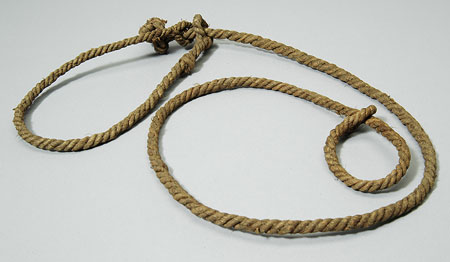Accession Number:
1931.66.22
Country:
Sudan
Region:
[Southern Sudan]
Cultural Group:
Nuer
Date Made:
By 1931
Materials:
Plant Fibre
Process:
Twisted , Looped , Knotted
Dimensions:
L = 1250 (main cord), L (moving noose) = 635 (extended), diam cord = 10.5 mm [RTS 30/11/2004].
Weight:
136.4 g
Other Owners:
Collected by Edward Evan Evans-Pritchard either in the early part of 1930 (probably February to April), or between February and June of 1931 [CM; RTS 9/7/2004].
Field Collector:
Edward Evan Evans-Pritchard
PRM Source:
Edward Evan Evans-Pritchard
Acquired:
Donated December 1931
Collected Date:
1930 - 1931
Description:
Cord noose used for hobbling restless cattle; this consists of two separate elements, linked to one another.
The main body is made of 3 lengths of twisted plant fibre, twisted into a thick cord.
At one end, this has been divided and the separate strands worked into a small loop; this loop was then fitted over the cord body, and tightened to form a short noose that can be widened by sliding the loop up and down the cord.
A second cord was added to provide an additional noose, that would be passed over the hind legs of a restless animal; this is of similar thickness to the main cord, and also made from 3 strands of plant fibre twisted together.
Each end has been divided to form a simple loop, which fits over the body of the main cord.
There is also a short piece of cord tied in a knot near one end.
This second cord was fitted onto the first, and then the end of that cord was tied off with a large knot, that would prevent the noose from slipping off as well as keep its component strands from unravelling.
The object is complete, with some minor fraying in places, and currently a light brown colour (Pantone 729C).
It has a weight of 136.4 grams and a cord diameter of 10.5 mm.
The longer cord has a length of 1250 mm; the shorter piece is 635 mm when stretched out to its full extent.
This object was collected by Edward Evan Evans-Pritchard during his first or second seasons of fieldwork amongst the Nuer, e.g.: in February to April 1930 or between February and June of 1931, in 'the dry season'. In the former, he spent around three and a half months in Leek territory at Yahnyang and Pakur on the Bahr el Ghazal, in Lou territory at Muot Dit, and at Adok, amongst the Dok Nuer. In the latter, he spent five and a half months at Nasir, on the Nyanding River, and at Yakwat on the Sobat River (see E.E. Evans-Pritchard, 1940, The Nuer , and the map of Evans-Pritchard's fieldwork in D.H. Johnson, "Evans-Pritchard, the Nuer, and the Sudan Political Service", African Affairs 81 no. 323, p. 233) (pers. comm. Chris Morton 2004).
This cord would be used to pull together the hind legs of a cow if it kicked out while being milked; the larger noose was fixed around the animal's legs, and the shorter end loop held in the hand (E.E. Evans-Pritchard, 1940, The Nuer, p. 22 and plate III). The published image was taken in the Yakwac cattle camp on the Sobat River, amongst the Lou Nuer (Chris Morton pers. comm. 2005).
Currently on display in the Upper Gallery, case 26A.
Rachael Sparks 18/9/2005.
This object was collected by Edward Evan Evans-Pritchard during his first or second seasons of fieldwork amongst the Nuer, e.g.: in February to April 1930 or between February and June of 1931, in 'the dry season'. In the former, he spent around three and a half months in Leek territory at Yahnyang and Pakur on the Bahr el Ghazal, in Lou territory at Muot Dit, and at Adok, amongst the Dok Nuer. In the latter, he spent five and a half months at Nasir, on the Nyanding River, and at Yakwat on the Sobat River (see E.E. Evans-Pritchard, 1940, The Nuer , and the map of Evans-Pritchard's fieldwork in D.H. Johnson, "Evans-Pritchard, the Nuer, and the Sudan Political Service", African Affairs 81 no. 323, p. 233) (pers. comm. Chris Morton 2004).
This cord would be used to pull together the hind legs of a cow if it kicked out while being milked; the larger noose was fixed around the animal's legs, and the shorter end loop held in the hand (E.E. Evans-Pritchard, 1940, The Nuer, p. 22 and plate III). The published image was taken in the Yakwac cattle camp on the Sobat River, amongst the Lou Nuer (Chris Morton pers. comm. 2005).
Currently on display in the Upper Gallery, case 26A.
Rachael Sparks 18/9/2005.
Primary Documentation:
Accession Book Entry
[IX, p.
16] 1931 [insert, in pencil] 66 [end insert]
E.
EVANS-PRITCHARD
, Esq.
Dec.
Specimens collected by himself in the EASTERN SUDAN, viz.
[...] [pencil insert, p.
18] 22 [end insert] - Hobbling-cord for cattle, with double noose, NUER.
Additional Accession Book Entry [p. 17] - 1931.66.22 No given AP [red biro] A20 F12 9.
Card Catalogue Entry - There is no further information on the tribes catalogue card [RTS 23/7/2004].
Old Pitt Rivers Museum label - Cord hobble for cattle, with double noose. NUER (NATH), E. SUDAN. Pres. by E. Evans-Pritchard, 1931 [front] 1931.66.22 [back] [rectangular, metal-edged tag, stored in RDF; RTS 30/11/2004].
Additional Accession Book Entry [p. 17] - 1931.66.22 No given AP [red biro] A20 F12 9.
Card Catalogue Entry - There is no further information on the tribes catalogue card [RTS 23/7/2004].
Old Pitt Rivers Museum label - Cord hobble for cattle, with double noose. NUER (NATH), E. SUDAN. Pres. by E. Evans-Pritchard, 1931 [front] 1931.66.22 [back] [rectangular, metal-edged tag, stored in RDF; RTS 30/11/2004].
Display History:
Current display label - EASTERN SUDAN, NUER.
Hobbling coard for restraining cattle, with double noose.
Collected and donated by E.E.
Evans-Pritchard.
1931.66.22 [in case U.26.A; RTS 13/12/2004].



